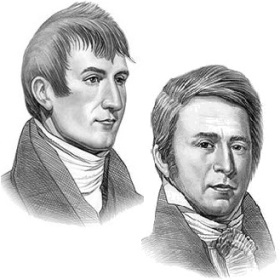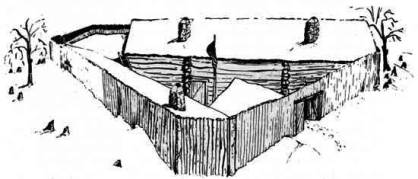|
|
|
|
|
|
9. The roofs of this type of building consisted of a simple ridgepole with split logs running down to the top of the wall, with the gables filled in with planks or timbers. The roofs would have been covered with anything that would prevent them from leaking. 10. The doors would have been made of planks and nails and probably had a wooden latch. 11. Fireplaces would have been made from either stone or mud brick, depending on what was available. chimneys were often placed between two rooms so that each room might share in the chimney. 12. The buildings in Fort Mandan were surrounded by a stockade, as with all military constructions of the period. to build the stockade a trench would first be dug and poles were then planted and the trench was then filled again. The poles would be held together by fixing them to cross pieces with wooden pegs. 13. The men of the Corps of Discovery had many other skills, besides soldiering and included carpenters and blacksmiths whose abilities were invaluable when building Fort Mandan. 14: The winter spent at Fort Mandan was bitterly cold and some of the men even suffered from frostbite. The Keelboat was frozen solid in the Missouri River and Captain Clark wrote that the Native Indians had to "...to bare more Cold than I thought it possible for man to endure." 15: The construction provided some shelter from the elements and the men spent much of their time indoors making and repairing their uniforms and repairing their equipment. 16. Whilst the expedition wintered at Fort Mandan they met Sacajawea who was just 16 years old and pregnant. Sacajawea was not supposed to be part of the expedition but her husband, Touissant Charbonneau, insisted that she came with them. The expedition also thought that they could use Sacajawea to help with navigating and in interpreting. Her child, named Pomp, was believed to have been born at the fort in February 1805. 17. Lewis and Clark prepared reports and specimens to be sent back home on the keelboat. 18. Despite the harsh weather conditions the men appeared to enjoy their time spent at Fort Mandan where they spent many nights with the Native Indians celebrating with dancing and singing and witnessing customs such as the famous Buffalo Dance. 19. In the spring of 1804, after wintering at Fort Mandan, a few members of the Lewis and Clark expedition returned home on the keelboat, loaded with plant and animal specimens and reports that were presented to President Thomas Jefferson. |
| Mobile Website Menu |
|
|
|
Published 2015 |
Modified 2018 |


